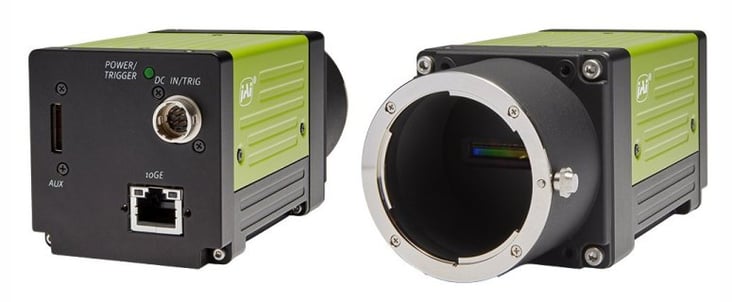JAI has rolled out a second version of its SW-4000TL trilinear color line scan camera – this one featuring a backwards-compatible 10 GigE interface. The new SW-4000TL-10GE features the same 4K (4096 pixels) line resolution and the same 66 kHz line rate for 24-bit non-interpolated RGB output as the original SW-4000TL-PMCL model. But instead of the Camera Link interface found on the original model, the SW-4000TL-10GE delivers its output over a versatile GigE Vision interface able to adjust to whatever speed the host or network can support.

Via integrated auto-negotiation technology the camera offers automatic backwards compatibility from 10GBASE-T (10 Gbps) to NBASE-T (5 Gbps and 2.5 Gbps) or the traditional 1000BASE-T (1 Gbps output) for customers running vision applications on these lower-speed Ethernet standards. This enables the SW-4000TL-10GE to support the broadest possible range of applications and makes it ideal for customers who want Ethernet flexibility, but want to gradually move up to higher interface speeds.
The high performance trilinear technology in the SW-4000TL-10GE has been combined with a broad set of advanced features - many of them unique among high speed trilinear cameras - to give designers an attractive alternative for applications not requiring the ultimate precision provided by JAI’s popular prism color line scan cameras.
For example, the custom CMOS imager features not just three, but six separate lines of 7.5-micron pixels with two lines each of red, green, and blue pixels. This arrangement makes it possible for the SW-4000TL-10GE to provide horizontal binning, vertical binning, or both – a feature not offered on other high-speed trilinear cameras. Furthermore, the sensor’s readout architecture combines the readout of two pixels through a single diffusion node to double the signal without increasing noise, enabling the binning process to dramatically increase sensitivity.
Another unique feature is the built-in color conversion capability that allows the SW-4000TL-10GE to provide native HSI or CIEXYZ color output, in addition to offering conversions from standard RGB to the sRGB or Adobe RGB color spaces, or even to a user-defined custom RGB conversion matrix.
The SW-4000TL-10GE features spatial compensation and tilted view correction functions to maintain proper synchronization and alignment of the R, G, and B channels. In addition, the camera features four separate input lines plus built-in algorithms to support direct connection from up to two rotary encoders. This capability enables the camera and web to be closely integrated as a single subsystem, while the camera’s only connection to the host is for the output of image data.
The direct encoder connection capability can also be used to daisy-chain multiple SW-4000TL-10GE cameras to each other in multi-camera setups, and can be used to automatically detect if the scan direction changes. If a reversal of direction is detected, the spatial compensation can be adjusted for the correct line sequence. This feature is extremely useful for scenarios such as when a reciprocating slide table is being used as the method of conveyance.
Additional standard features include gain and black level adjustment, manual or automatic white balancing, shading correction, PRNU and DSNU correction, timestamps, and support for GigE Vision features such as delayed readout, action commands, and GenICam-compliant chunk data (meta data).
The SW-4000TL-10GE utilizes a standard RJ-45 connector for output via Cat5e, Cat6/6e/6A, or Cat7 cable, depending on the Ethernet standard under which the camera is operating. 3 x 8-bit and 3 x 10-bit output is user selectable, as well as YUV422_8 and YUV422_8_UYVY formats.
Two different lens mount options are available – a Nikon F-mount or an M42x1 mount with a 16 mm flange back distance.
More information:
Download datasheet and learn more about the Sweep SW-4000TL-10GE color line scan camera here
Read and/or download our Tech Guide on color imaging solutions.

